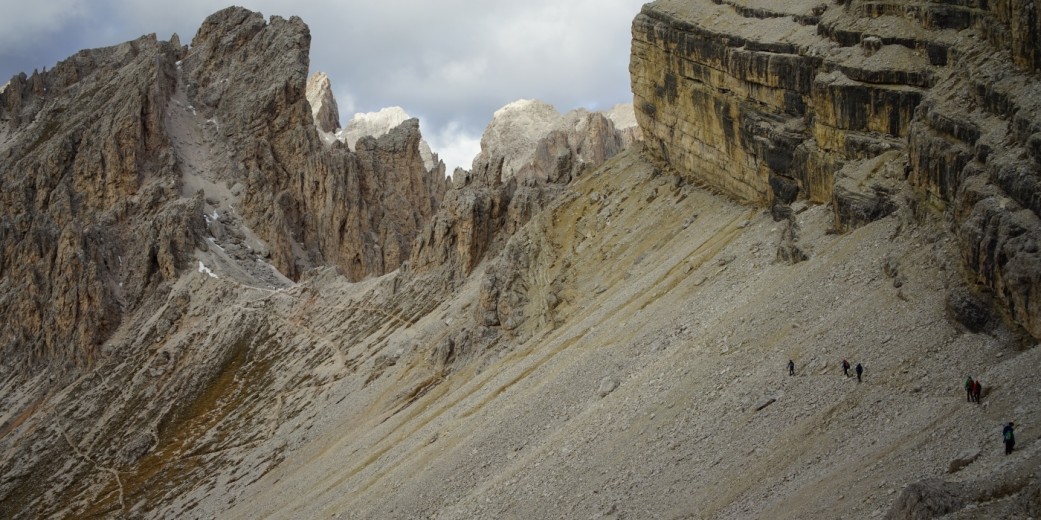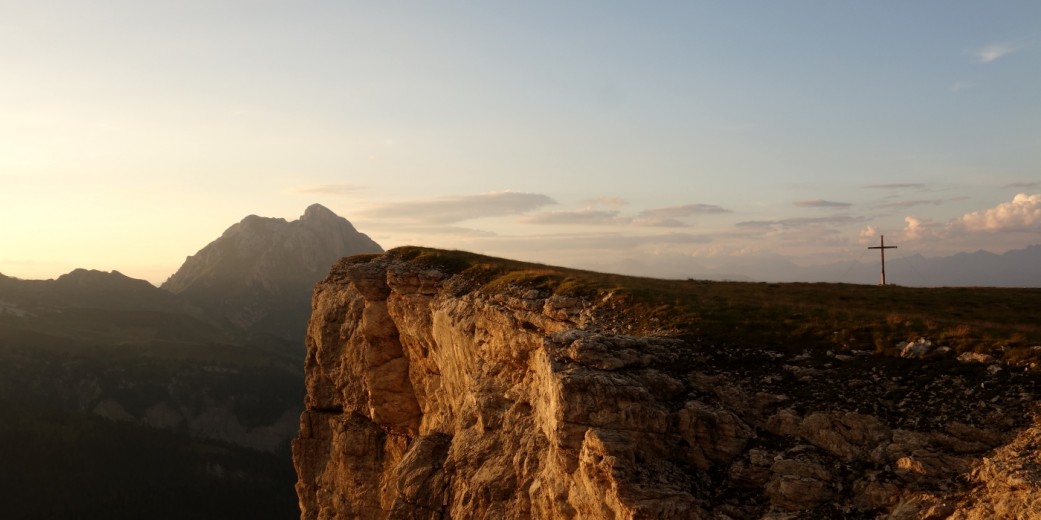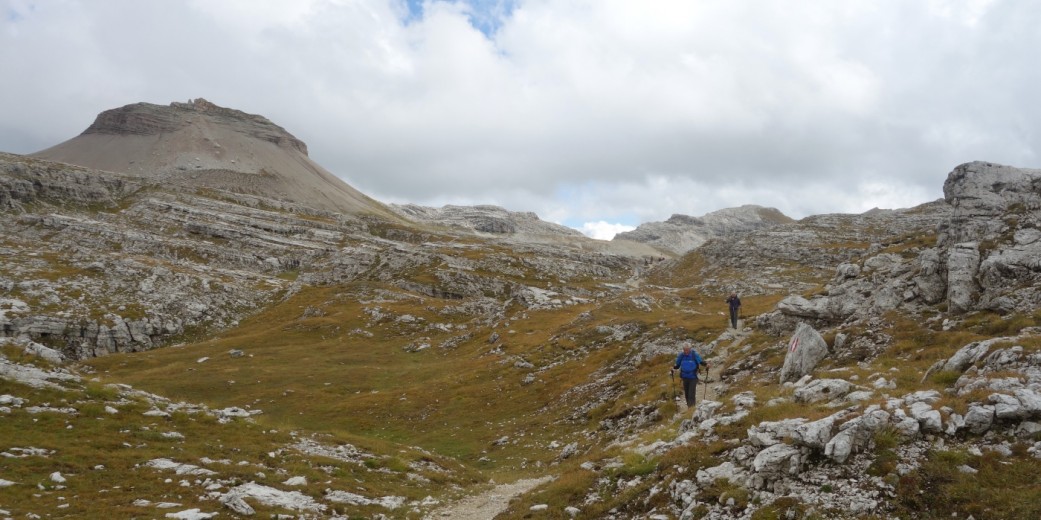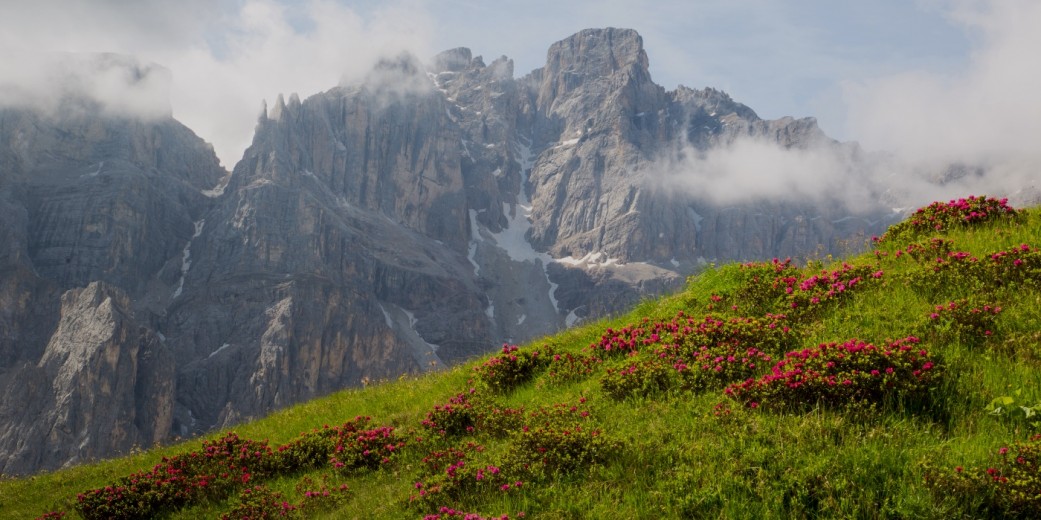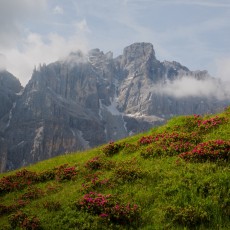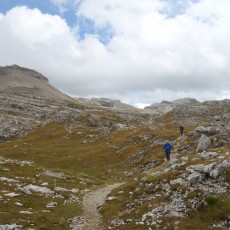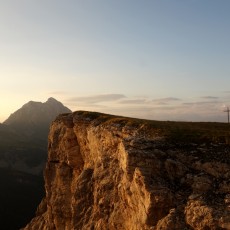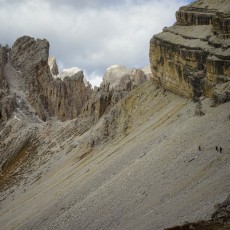Starting from Cialdires
Crëp dales Dodesc / Zwölferkofel
The Crëp dales Dodesc/ Zwölferkofel – “The Twelfth” is classed as an easy mountain tour and, as such, is doable even for children. The summit boasts a unique view over the Campill Valley and is a top tip amongst local for beautiful sunsets.
- Highest point: 2,384 m, Crëp dales Dodesc / Zwölferkofel
- Altitude difference: 800 m
- Time: 2-3 h
The tour begins at the Cialdires car park and leads to the Antersasc Alm Alpine pasture (see walks). From there, by the single stone pine on the rock (an excellent landmark), climb up to the summit. The descent follows the same route.
Piza de Pöz / Östliche Puezspitze
Although the Piza de Pöz/ Eastern Puezspitze is best known as a popular ski tour in winter, it is most certainly well worth a climb in summer. From the Cialdires car park the tour leads first to the Antersasc Alm Alpine pasture (see walks).
- Highest point: 2,913 m, Piza de Pöz / Östliche Puezspitze
- Altitude difference: 1,400 m
- Time: 5-6 h, variation: 7-8
When you pass the single stone pine on the rock, trail no. 9 leads to the left towards the Forcela de Pöz/ Puezscharte saddle, where you continue onwards to the Puez high plateau and the nearby Puez hut. Trail no.14 leads past the Col de Puez/ Puezkofel (2,725 m) to the Piza de Pöz/ eastern Puezspitze peak.
There are two possible routes for the descent: you can either take the same route back or the slightly longer alternative from the hut, up towards Forcela Nives/ Nives-Scharte ascending and down the Forcela dla Roa/ Roa-Scharte, back to the starting point.
Col dala Soné
Soaring in volcano-like solitude in the middle of the Puez high plateau, the Col dala Soné is not only an impressive sight, but also fascinating from a geological point of view.
- Highest point: 2,633 m, Col dala Soné
- Altitude difference: 1,000 m
- Time: 4 – 5 h
The first stretch of the ascent leads to the Puez hut (see tour Östliche Puezspitze). From there, as you head east on trail no. 15, the isolated peak soon soars up before you. Take the same route for the descent. Alternatively, the path north leads to another peak, the Ciampanì (2,668 m) with outstanding views of the Antersasc Valley. From there, take trail no.1 down to Forcela de Pöz/ Puezscharte.
Lungiarü – Puez – Grödnerjoch pass
The base for the Dolomites Höhenweg High Mountain Trail between the massifs of the Puez Group is the Puez hut with its incredible nature and mountains.
- Highest point: 2,528 m
- Altitude difference: 940 m
- Time: 5 – 6 h
For the climb to the hut, follow the directions for the Piza de Pöz/ Östliche Puezspitze tour. When you arrive at the hut, take trail no. 2 up to the Crespeinajoch, passing the Crespeinasee Lake on the way. With the beautiful view of the Sella massif to restore your energy, make your way down to Jimmy’s hut and on to the Grödner Joch pass and return to Lungiarü by public transport.
Starting from Pares
Forcela dla Roa / Roa-Scharte – Piz Duleda
This challenging tour calls for good stamina and physical condition. It begins at Pares and leads into the valley, along forest road no. 5A.
- Highest point: 2,909 m
- Altitude difference: 1,310 m
- Time: 7-8 h
The Höhenweg High Mountain Trail no. 2 then leads to the Forcela dla Roa/ Roa pass – the border of the Grödner Tal Valley – and on in the direction of Forcela Nives/ Nives-Scharte saddle along trail no. 3A via a small, secured path. From the saddle, turn left onto Piz Duleda.
The reward: a breathtaking view of the Villnöss Geisler, the Sella Massif, the Marmolada and many more famous mountains!
To return, you can either take the same route or go back via Puez and Antersasc.
Multi-day tour: Lungiarü – Regensburgerhütte mountain hut – Glatschalm – Lungiarü
Diese Dreitagestour führt durch die beeindruckende Felsszenerie der Geislergruppe und entlohnt jegliche Mühen mit unvergesslichen Impressionen.
Day 1: Beginning from Pares we follow trail no. 5A, until we cross the Dolomites Höhenweg High Mountain Trail. After a few metres, turn right and take trail no. 13 to the Forcela de Munt dal ‘Ega/ Wasserscharte (2,642 m). Surrounded by countless rock towers, we now switch to the other side of the valley and descend over steep gravelly terrain on trail no. 13 towards the Regensburgerhütte mountain hut.
Day 2: From the Regensburgerhütte mountain hut, you can climb the mighty Sas Rigais (3,025 m) on the via ferrata on the eastern slope to or, alternatively, take the slightly easier southwestern slope.
From the summit we descend to the Mittagsscharte (2,597 m) and, along a number of steep hairpin bends during the initial stretch, come to the Adolf-Munkel-Weg trail which runs from east to west at the foot of the Geisler Group. We then follow the footpath to the turnoff to the left and take trail no. 36 to Glatschalm (1,902 m).
Day 3: From the Glatschalm we first follow trail no. 36B until we come to the Adolf- Munkel-Weg (no. 35). From there we continue to Tschantschenon and take the beautiful trail no. 33 up to the Forcela de Furcia/ Kreuzjoch (2,293 m), which boasts fabulous views of the Puez peaks, and return to Lungiarü on trail no. 5 over gentle mountain meadows.
Günther-Messner-Ascent
On this beautiful but demanding day trip, unsecured trails alternate with roped stretches. The reward is the widely underrated natural beauty of the Aferer Geisler.
- Highest point: 2,646 m
- Altitude difference: ca.1,700 m
- Time: 8-9 h
Beginning in Pares, follow the route through the Mühlental Valley on trail no.4B to Forcela de Pütia/ Peitlerscharte. From here, make your way down to the crossroads. Keep to the left and follow the trail marked GM, past the lowest point, the Russiskreuz. Now ascend to another fork (ascent to Tullen, 2,653 m, possible on the left). From there, follow the ascent route on trails which are secured with wire rope in some stretches. The trail runs north in part, but mainly south. Then return to the Forcela de Pütia/ Peitlerscharte on the south-facing meadows. The descent leads through the Val di Morins/ Mühlental.
Starting from Ví
Pütia / Peitlerkofel
The Pütia/ Peitlerkofel not only delineates the northern end of the South Tyrolean Dolomites, but is without a doubt one of the most beautiful mountains in the Dolomites – the sunrises here are practically legendary.
- Highest point: 2,875 m
- Altitude difference: 1,300 m
- Time: 5-6 h
We begin at Ví and follow the forest road no. 9, until we come to the Peitlerkofel loop route (No. 35). With the Ütia Vaciara hut behind us, we head onwards on the slightly more level trail over the Pra de Pütia/ Peitlerwiesen towards Scharte.
Trail no. 4B, with a number of curves, only moderately steep, brings us up to the saddle between the large and the small Peitlerkofel, while a well-secured via ferrata leads up to the main summit where you can enjoy a breathtaking panorama: to the north, you can see the Grossglockner and the Grossvenediger, to the west the Ötztal Alps, the Ortler and the Brenta Groups, and to the south and the east the remaining Dolomites. Those who are wary of the ascent to the main summit can easily walk to the Picia Pütia/ Kleinen Peitlerkofel (2,813 m). The descent follows the ascent route.


